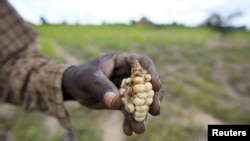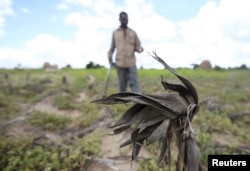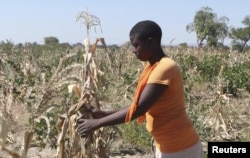Preparing his three-hectare plot of land for planting each year used to take Musafare Chiweshe — or the laborers he hired — two weeks. Now it takes just hours.
Better yet, the land is producing a crop even as southern Africa's droughts grow stronger and more frequent, a problem linked to climate change.
That's because Chiweshe is no longer plowing a portion of his farm, but instead planting his seeds directly into the intact soil, a water-conserving technique called no-till farming.
"Come next year you will find even bigger cobs in my field," promised the 67-year-old retired bus driver, who this year expects to harvest 2 tons of maize from a half-hectare no-till trial plot.
No-till farming is hardly new. Three decades ago, Zimbabwe's commercial farms adopted the technique and it has been promoted by Zimbabwe research and development organizations since 2004.
But it is seeing new popularity among small-scale farmers in Zimbabwe as many, shaken by a recent long drought that killed crops, look for ways to avoid a repeat of those losses the next time drought returns.
About 300,000 small-scale farmers in Zimbabwe, most of whom depend on rainfall to water their crops, are now using the no-till farming system, according to Christian Thierfelder, an agronomist with the southern Africa regional office of the International Maize and Wheat Improvement Center (CIMMYT).
Besides planting seeds directly into the soil, no-till farming involves allowing the stalks and leaves left from earlier harvests to remain on the ground, to help hold moisture and eventually add nutrients to the soil, building soil fertility over time.
Often weeds are sprayed with herbicides rather than removed by digging them from the soil.
The technique has had problems of its own over the last growing season, marked by flooding and heavy rains. In some areas where soils are sandy, farmers practicing no-till farming saw yields no higher than those of farmers who plowed their land.
More maize, fewer hassles?
But for some farmers, like Chiweshe, the new style of farming is proving more reliable than the old way of doing things, which "was stressing" in the face of worsening drought, he admits.
Before taking up no-till farming, he said he harvested just one ton of maize from his 3-hectare plot last year, during the drought. This year he expects twice that from just one-sixth of his land.
Eliminating plowing and other labor also is saving money, he said, and giving him more time to concentrate on other money-makers on his farm, such as bananas and livestock.
Thierfelder said conventional farming equipment — such as plows — can be converted into specialized no-till equipment for an investment of about $25.
In Malawi, no-till farmers find they need to spend 25 to 45 fewer days each season weeding their fields using animal-pulled equipment — though they then need to buy and use herbicides to get rid of weeds without tilling the land, Thierfelder said.
Efforts to spread the use of no-till farming in Zimbabwe, in the face of worsening climate change impacts, have been hampered by a lack of sufficient trainers to help farmers make the adjustment, he said.
Under a 2011 government plan to promote the practice, each of the country's 4,300 farm extension officers was expected to train at least 75 farmers a year, said Phillimon Ngirazi, an extension officer from Chavakadzi in Shamva District, 120 km northwest of Harare.
But not all extension officers have reached that goal, he said.
"Changing minds that crop production is possible without plowing has been difficult. But once farmers have experience with conservation agriculture practices for some time, they influence other farmers," Ngirazi said.











